Viral Infections in the Mouth (Symptoms with Pictures)
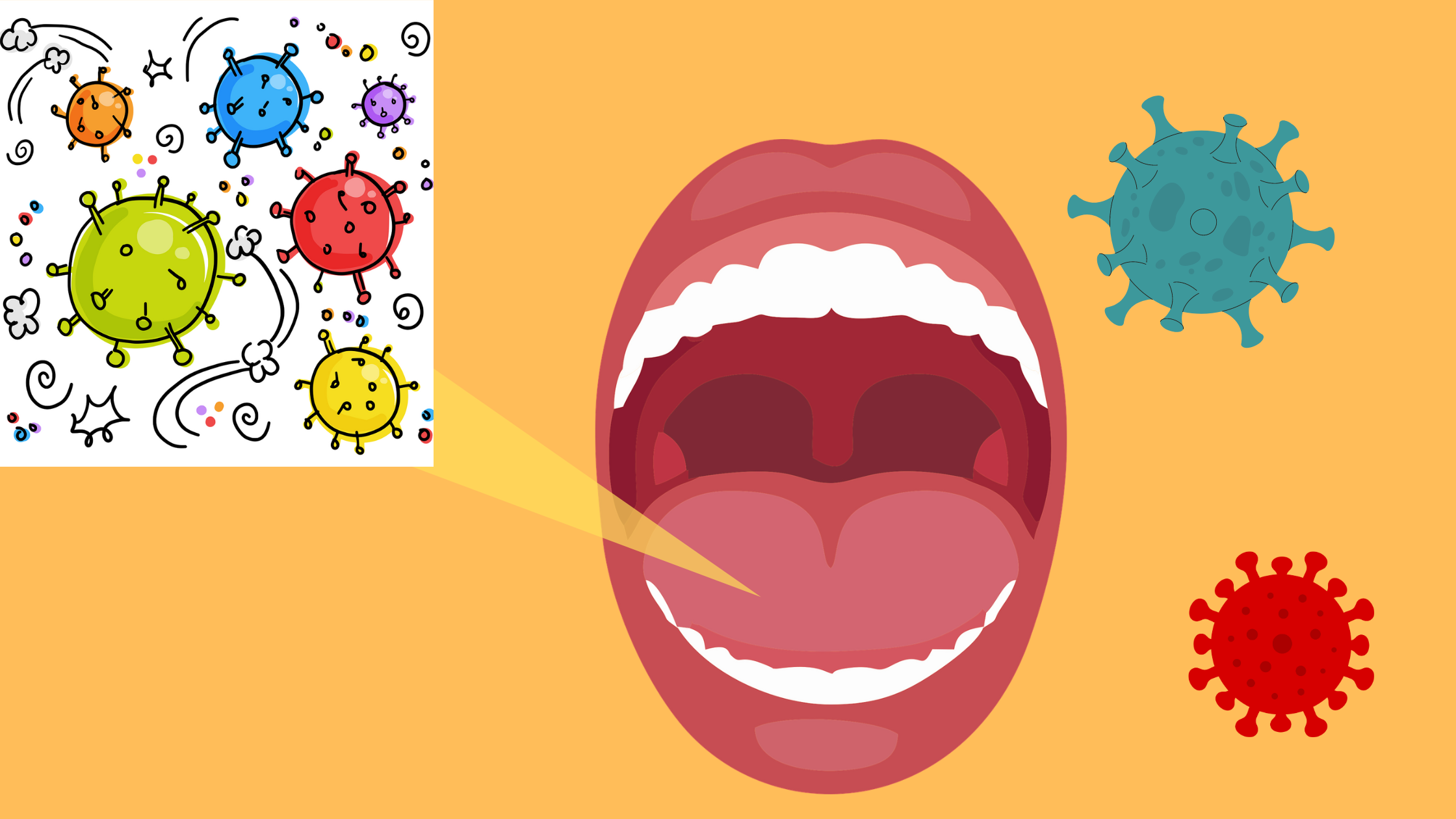 Your mouth is a common gateway for many viruses and bacteria.
Your mouth is a common gateway for many viruses and bacteria.
Some viral infections can settle directly in the mouth and cause noticeable symptoms. Two of the most common examples are the herpes virus, which causes cold sores (also known as fever blisters), and human papillomaviruses (HPVs), which can lead to benign tumors commonly known as warts.
In this article, we’ll take a closer look at the different types of viral infections that can affect your mouth and the symptoms to watch out for.
In this article:
1. Herpes virus infection: Cold sores
2. Varicella-Zoster Virus Infections:
3. Human Papillomavirus Infection (HPV):
4. Coxsackie viral infection (Hand, foot, and mouth disease):
5. HIV (human immunodeficiency virus):
1. Herpes virus infection: Cold sores
Herpes virus infections are well-known for causing mouth ulcers called cold sores or fever blisters.About 3.7 billion people under age 50 (around 67% of the world’s population!) carry herpes simplex virus type 1 (HSV-1), which is the main type involved in oral herpes.
Most of the time, the virus stays dormant and causes no symptoms, so you may not even know you have it.
However, certain triggers — like an injury, stress, illness, hormonal changes, or sun exposure — can reactivate the virus and cause a herpes outbreak. Cold sores appear as small, fluid-filled blisters, usually on or around the lips.
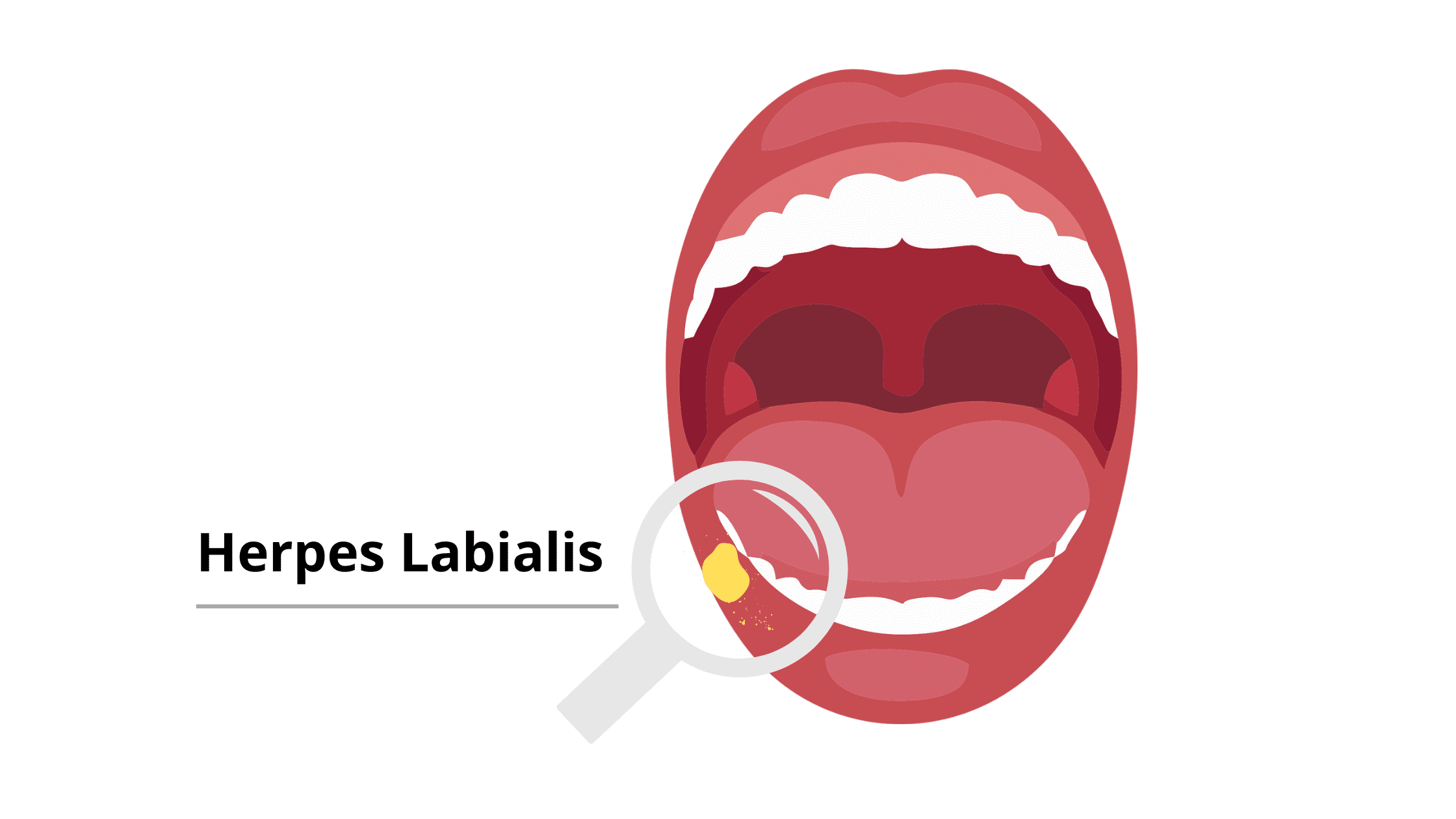
Cold sores are highly contagious and can be transmitted through direct contact with the blisters or with the affected area.
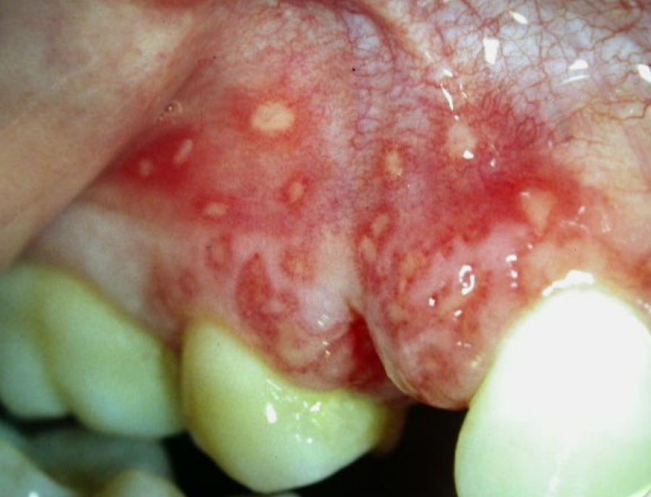
Mouth Symptoms of Herpes Infection
Mouth symptoms of a herpes infection usually show up as multiple ulcers or sores with these features:
- Itching, tingling, or a burning sensation before the cold sores develop.
- Small, fluid-filled blisters that appear on or around the lips, nose, chin, or cheeks.
- Pain or discomfort in the affected area.
- Blisters may break open, forming shallow ulcers or sores.
- Cold sores can be uncomfortable and may take about 1 to 2 weeks to heal completely.
2. Varicella-Zoster Virus Infections:
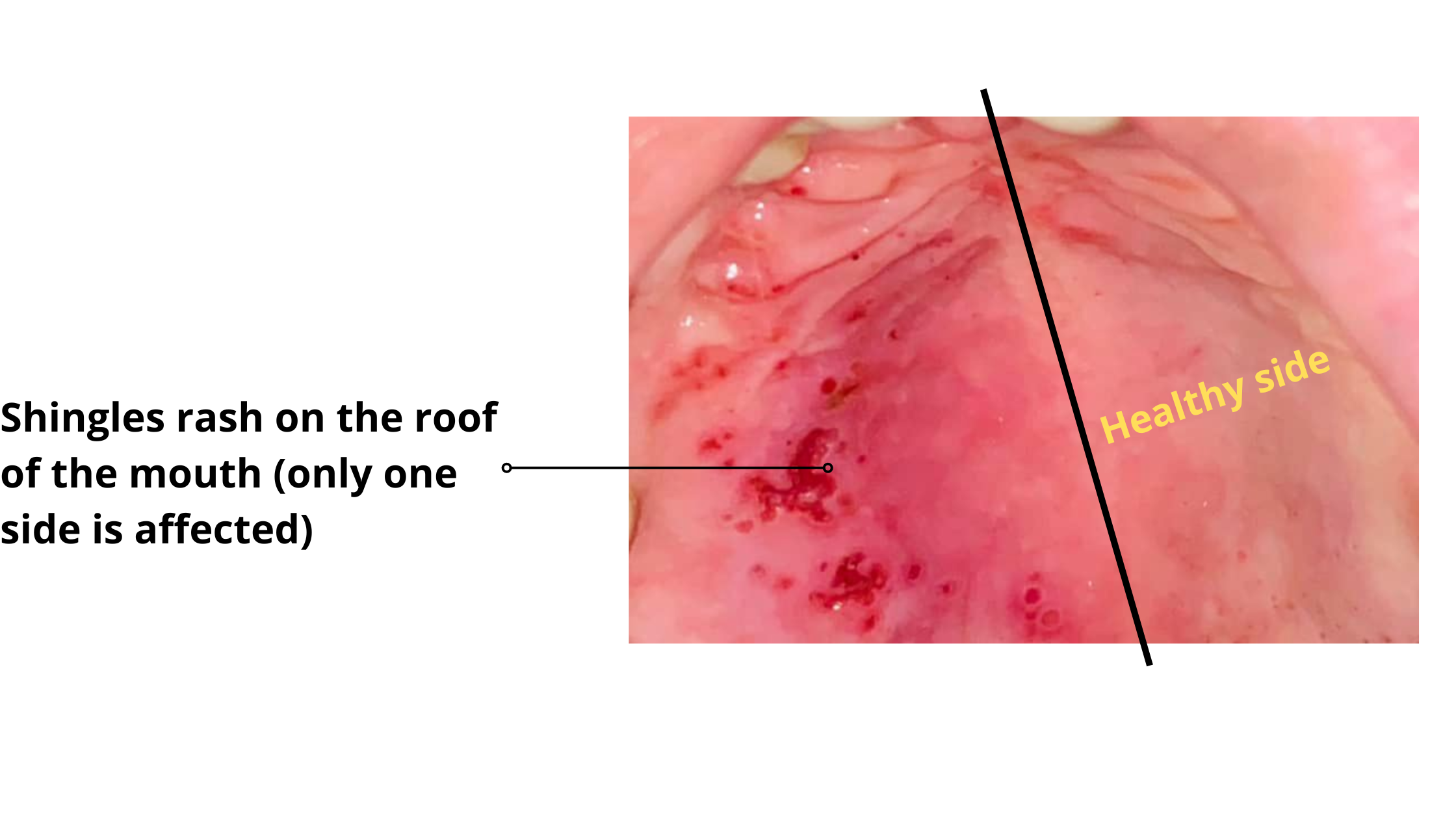
Varicella-zoster virus (VZV) infections are also common. Over 95% of people carry the dormant form of VZV. In the United States, around 1 in 3 people will develop a recurrent infection (mostly older adults).
The infection has two stages:
The first stage is called chickenpox, which occurs when you get the virus for the first time — typically in childhood. It causes itchy, fluid-filled blisters that cover the entire body. Chickenpox spreads mainly through respiratory droplets from an infected person or direct contact with fluid from their blisters.
After this stage, the virus goes dormant in the body’s nerves.
The second stage is called herpes zoster, or shingles, which can occur later in life, especially in older adults. Why? Because the immune system weakens with age, which allows the dormant virus to reactivate and cause an outbreak.
Shingles leads to a painful rash that can appear anywhere on the body, including inside the mouth. What sets shingles apart is that the sores affect only one side (right or left), while the other side remains unaffected (as shown in the image above).
Mouth symptoms of VZV
Mouth symptoms of varicella-zoster virus infections (chickenpox and shingles) are generally similar. These may include:
- Small, itchy blisters or sores on the inside of the mouth and throat.
- Pain or discomfort while eating or drinking, especially if the blisters are present on the tongue, gums, or inside the cheeks.
- Swelling or redness in the mouth.
- Burning sensation in the face.
3. Human Papillomavirus Infection (HPV):
Human papillomavirus (HPV) infection is caused by the human papillomavirus, which is very common and can affect both men and women. It’s mainly spread through direct contact (especially sexual contact).There are more than 200 types of HPV, but not all of them cause symptoms in the mouth. HPV types 2 and 4 are the most well-known for affecting the mouth.
When these viruses settle on the skin or the lining of the mouth, they affect the outer cells and cause benign growths known as warts.
These infections are usually harmless and are easily controlled by a healthy immune system.
However, some types of HPV are more serious and carry a higher risk of cancer — especially HPV-16.
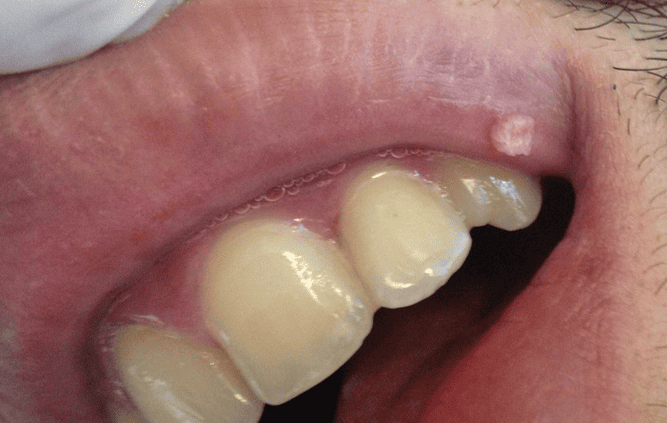
Mouth Symptoms of HPV Infection:
HPV infections often show up in the mouth because the virus can easily infect the lining inside the mouth. Signs may include:
- Oral warts: HPV can cause small, painless warts to develop anywhere in the mouth. These growths can be called verruca vulgaris, condyloma, or papilloma.
- Sore throat: A persistent or recurring sore throat without an obvious cause may be a symptom of an HPV infection.
- Hoarseness or voice changes: If HPV affects the vocal cords, it can lead to hoarseness or other changes in your voice.
4. Coxsackie viral infection (Hand, foot, and mouth disease):
Coxsackie viral infection, better known as hand, foot, and mouth disease (HFMD), is a highly contagious viral illness caused by the Coxsackie virus. It mostly affects children under the age of 5 but can sometimes occur in adults too.HFMD spreads mainly through close contact with someone who is infected. This includes respiratory droplets from coughing or sneezing, contact with blister fluid or saliva, and touching contaminated surfaces or objects.
The disease gets its name from its most common symptoms: a rash or sores on the hands, feet, and inside the mouth.
Mouth Symptoms of Hand, Foot, and Mouth Disease:
The rash on the hands, feet, and mouth is usually preceded by fever, fatigue, and difficulty swallowing. Here are some oral signs to watch for:
- Painful mouth sores: Small red spots or ulcers can appear inside the mouth — on the tongue, gums, and inner cheeks. These sores can be tender and make eating or drinking uncomfortable.
- Blister-like lesions: Fluid-filled blisters that look like bubbles may develop on any mouth area. These can be painful but usually heal within a few days.
- Sore throat: The throat may become sore and painful, causing discomfort when swallowing.
5. HIV (human immunodeficiency virus):
HIV, short for human immunodeficiency virus, is a virus that attacks your body's immune system. Specifically, it targets a type of immune cells known as CD4 cells or T-helper cells, which are essential for fighting off infections and diseases.When HIV weakens your immune system, it makes you more vulnerable to various illnesses and infections.
If left untreated, HIV can progress to a more advanced stage known as AIDS (acquired immunodeficiency syndrome).
Among the body parts to show the first signs are the face and mouth. In fact, 50% of HIV-infected patients and up to 80% of patients in the AIDS stage have oral manifestations of the virus.
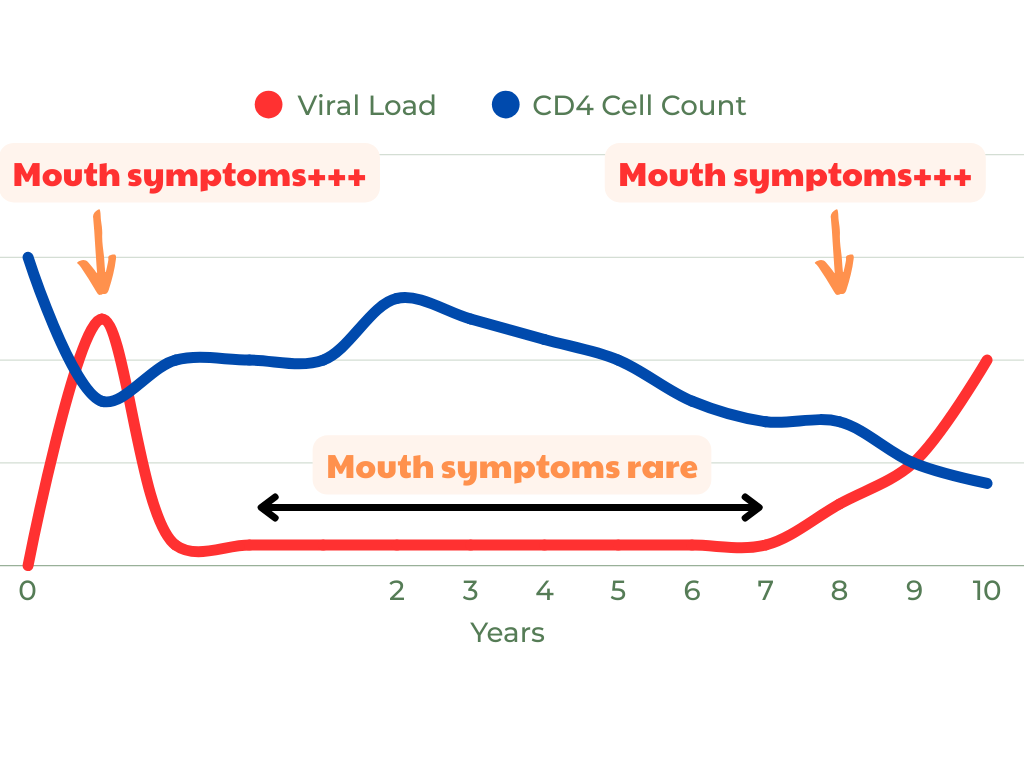
HIV Transmission:
HIV is transmitted mainly through unprotected sexual contact.
The virus does not spread through skin contact. To contract the virus, the body fluids (such as blood, semen, and vaginal secretions) you come into contact with must contain a high viral load. Plus, they have to enter your bloodstream through a wound or mucus membranes (such as the inner lining of your mouth).
Casual contact or skin exposure alone does not put you at risk of HIV transmission.
Mouth symptoms of HIV
The challenge with HIV is that it gradually wears down your immune system over time. If left untreated, HIV will eventually overpower your body’s defenses.
As your immune system weakens, other bacteria and viruses can take over, causing additional infections and conditions (including some cancers!).
Here are some signs to watch for:
- Thrush: This is a fungal infection caused by a yeast called Candida. Thrush appears as white patches on the tongue, inner cheeks, or the roof of the mouth.
- Oral hairy leukoplakia: This condition presents as white, raised, and hairy-looking patches on the side of the tongue.
- Painful mouth sores: People with HIV infection often show painful ulcerations or sores in the mouth.
- Gum disease: HIV can increase the risk of gum disease, leading to inflammation, bleeding gums, and eventually, tooth loss if not properly managed.
- Dry mouth: Dry mouth, also known as xerostomia, is a common oral manifestation in individuals with HIV. It occurs when the salivary glands do not produce enough saliva, leading to a dry and uncomfortable sensation in the mouth.
- Cavities: HIV infection can increase the risk of developing cavities. This is primarily due to a combination of factors, including a weakened immune system, reduced saliva production, and changes in oral hygiene habits.
How long before HIV shows symptoms?
When you first contract the virus, signs don’t appear immediately. Initial symptoms may take several weeks to show up and often resemble those of the flu.
After this initial phase, HIV may cause no symptoms for years, quietly multiplying within the body.
Later, the virus can progress and lead to the AIDS stage.
Takeaway
While viral infections in the mouth can be uncomfortable, most aren’t serious and usually clear up on their own as your body fights them off.
However, many other oral conditions can cause similar symptoms, like ulcers, rashes, or blisters. While most are harmless, some can be more serious and may need treatment.
A good rule to remember is this: if you have a symptom in your mouth that lasts unusually long — more than two weeks — don’t wait! Make sure to see your dentist or doctor for a proper checkup.
However, many other oral conditions can cause similar symptoms, like ulcers, rashes, or blisters. While most are harmless, some can be more serious and may need treatment.
A good rule to remember is this: if you have a symptom in your mouth that lasts unusually long — more than two weeks — don’t wait! Make sure to see your dentist or doctor for a proper checkup.
Sources
- Pathogenesis and disease - Human Herpesviruses - NCBI Bookshelf (nih.gov)
- HIV Transmission | HIV Basics | HIV/AIDS | CDC
- Oral Manifestations Associated with HIV/AIDS Patients - PMC (nih.gov)
- Herpes simplex virus (who.int)
- Oral manifestations of human papillomavirus infections - PubMed (nih.gov)
- Herpes zoster epidemiology, management, and disease and economic burden in Europe: a multidisciplinary perspective - PMC (nih.gov)
- Essentials of Oral Pathology by Swapan Kumar Purkait (Author)
- Oral Medicine (A Colour Handbook) by Michael A.O. Lewis (Author), Richard C.K. Jordan (Author)
- Shingles (Herpes Zoster) https://www.cdc.gov/shingles